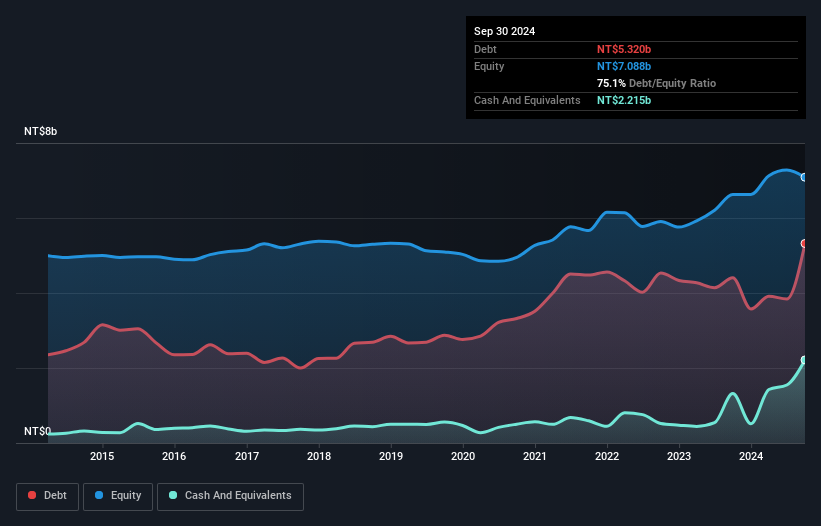Howard Marks put it nicely when he said that, rather than worrying about share price volatility, 'The possibility of permanent loss is the risk I worry about... and every practical investor I know worries about.' So it might be obvious that you need to consider debt, when you think about how risky any given stock is, because too much debt can sink a company. We note that Quintain Steel Co., LTD. (TWSE:2017) does have debt on its balance sheet. But is this debt a concern to shareholders?
When Is Debt A Problem?
Debt assists a business until the business has trouble paying it off, either with new capital or with free cash flow. Ultimately, if the company can't fulfill its legal obligations to repay debt, shareholders could walk away with nothing. However, a more common (but still painful) scenario is that it has to raise new equity capital at a low price, thus permanently diluting shareholders. Of course, debt can be an important tool in businesses, particularly capital heavy businesses. The first step when considering a company's debt levels is to consider its cash and debt together.
View our latest analysis for Quintain Steel
What Is Quintain Steel's Debt?
You can click the graphic below for the historical numbers, but it shows that as of September 2024 Quintain Steel had NT$5.32b of debt, an increase on NT$4.40b, over one year. However, it also had NT$2.22b in cash, and so its net debt is NT$3.10b.

How Strong Is Quintain Steel's Balance Sheet?
The latest balance sheet data shows that Quintain Steel had liabilities of NT$4.47b due within a year, and liabilities of NT$1.82b falling due after that. On the other hand, it had cash of NT$2.22b and NT$425.4m worth of receivables due within a year. So it has liabilities totalling NT$3.64b more than its cash and near-term receivables, combined.
This deficit is considerable relative to its market capitalization of NT$5.25b, so it does suggest shareholders should keep an eye on Quintain Steel's use of debt. This suggests shareholders would be heavily diluted if the company needed to shore up its balance sheet in a hurry. When analysing debt levels, the balance sheet is the obvious place to start. But you can't view debt in total isolation; since Quintain Steel will need earnings to service that debt. So when considering debt, it's definitely worth looking at the earnings trend. Click here for an interactive snapshot.
Over 12 months, Quintain Steel reported revenue of NT$3.2b, which is a gain of 5.1%, although it did not report any earnings before interest and tax. That rate of growth is a bit slow for our taste, but it takes all types to make a world.
Caveat Emptor
Over the last twelve months Quintain Steel produced an earnings before interest and tax (EBIT) loss. Indeed, it lost NT$239m at the EBIT level. Considering that alongside the liabilities mentioned above does not give us much confidence that company should be using so much debt. So we think its balance sheet is a little strained, though not beyond repair. However, it doesn't help that it burned through NT$711m of cash over the last year. So suffice it to say we consider the stock very risky. The balance sheet is clearly the area to focus on when you are analysing debt. But ultimately, every company can contain risks that exist outside of the balance sheet. Be aware that Quintain Steel is showing 3 warning signs in our investment analysis , and 2 of those are a bit concerning...
When all is said and done, sometimes its easier to focus on companies that don't even need debt. Readers can access a list of growth stocks with zero net debt 100% free, right now.
Valuation is complex, but we're here to simplify it.
Discover if Quintain Steel might be undervalued or overvalued with our detailed analysis, featuring fair value estimates, potential risks, dividends, insider trades, and its financial condition.
Access Free AnalysisHave feedback on this article? Concerned about the content? Get in touch with us directly. Alternatively, email editorial-team (at) simplywallst.com.
This article by Simply Wall St is general in nature. We provide commentary based on historical data and analyst forecasts only using an unbiased methodology and our articles are not intended to be financial advice. It does not constitute a recommendation to buy or sell any stock, and does not take account of your objectives, or your financial situation. We aim to bring you long-term focused analysis driven by fundamental data. Note that our analysis may not factor in the latest price-sensitive company announcements or qualitative material. Simply Wall St has no position in any stocks mentioned.
About TWSE:2017
Quintain Steel
Manufactures and sells of steel wires and processed products in Taiwan and internationally.
Imperfect balance sheet with very low risk.
Similar Companies
Market Insights
Community Narratives



